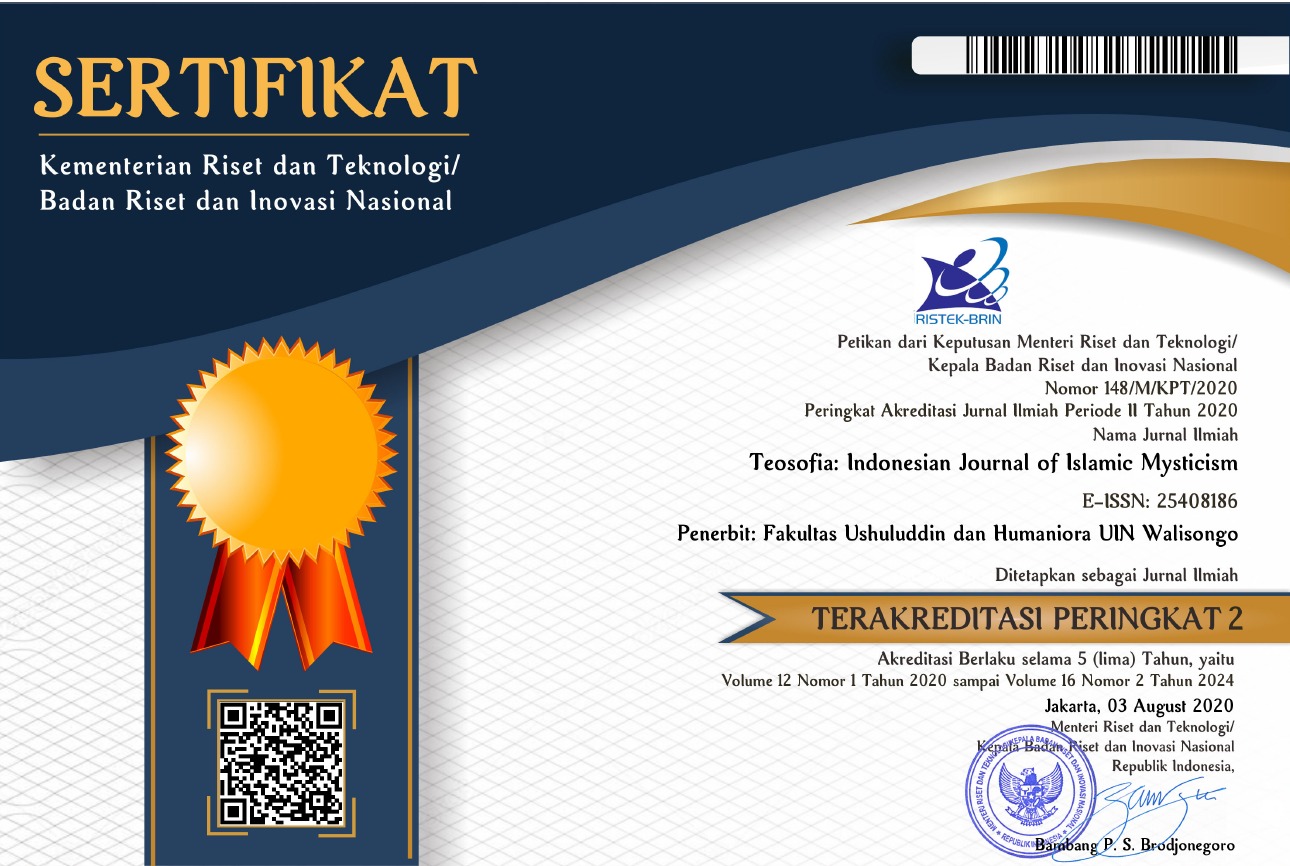Ṭarīqa Followers and Inner Peace: A Phenomenological Study of Naqshbandiyya-Khālidiyya Order in Indonesia
DOI:
https://doi.org/10.21580/tos.v11i1.10503Keywords:
inner peace, problem-solving, self-efficacy, remembering God, Naqshbandiyya-Khālidiyya OrderAbstract
This paper aims to reveal the inner peace dynamics of followers of the Naqshbandiyya-Khālidiyya Order. It employs a qualitative approach with the phenomenological method and in-depth analysis to describe the followers' inner peace dynamics. Interviews and observations have been carried out to collect data. Data reduction, presentation, conclusion drawing, and verification are employed. This study reveals that reaching inner peace dynamics needs problem-solving. The second step is making the decision. The third step is finding the solution to solve the problems to find the right strategy for a particular situation. The fourth step is being patient by emotional restraint. The last step is embracing faith and self-efficacy in dealing with problems. Faith is obtained from dhikr as it will lead to remembering God. The stages and aspects of inner peace are different from Mujib and Mudzakkir's theory. In addition, this study found that internalizing the value of murshid and self-approach to God positively impact inner peace.
Contribution: This article contributes to a new finding about the stages of achieving mental peace. So, everyone can seek peace of mind through these various stages. In addition, the Ṭarīqa can also optimize its role because the murshid is considered necessary for increasing peace of mind.
Downloads
References
Aceh, Abubakar. Pengantar Ilmu Tarekat: Uraian Tentang Mistik. Solo: Ramdhani, 1985.
Aydin, Hayati. “Positive Effects of Believing, Prayer, and Spending in Charity on the Inner Peace of Believers.” Global Journal Al-Thaqafah 3, no. 2 (2013): 37–43. https://doi.org/10.7187/GJAT412013.03.02.
Bakri, Syamsul. “Mbah Manshur Popongan: Guru Sufi Tarekat Naqsyabandiyah-Khalidiyah Di Jawa.” In Menelusuri Jejak Enam Kiai Di Solo Raya, edited by Ahmad Saifuddin and Shofi Puji Astiti. Surakarta: Bukuku Media, 2017.
Bakri, Syamsul, and Ahmad Saifuddin. Sufi Healing: Integrasi Tasawuf Dan Psikologi Dalam Penyembuhan Psikis Dan Fisik. Depok: Rajagrafindo Persada, 2019.
Baldacchino, Donia, and Peter Draper. “Spiritual Coping Strategies: A Review of the Nursing Research Literature.” Journal of Advanced Nursing 34, no. 6 (2001): 833–41. https://doi.org/10.1046/j.1365-2648.2001.01814.x.
Bandura, Albert. “On the Psychosocial Impact and Mechanisms of Spiritual Modeling.” The International Journal for the Psychology of Religion 13, no. 3 (2003): 167–73.
———. “Self-Efficacy: Toward A Unifying Theory Of Behavioral Change.” Psychological Review 84, no. 2 (1977): 191–215. https://doi.org/10.1037/0033-295X.84.2.191.
Baqutayan, Shadiya Mohamed Saleh. “Stress and Coping Mechanisms: A Historical Overview.” Mediterranean Journal of Social Sciences 6, no. 2 (2015): 479–88. https://doi.org/10.5901/mjss.2015.v6n2s1p479.
Bhandari, Sudama S. “Literature in Pursuit of Inner Peace.” An International Peer Reviewed & Refereed: Scholarly Research Journal for Humanity Science & English Language 3, no. 18 (2016): 4019–22. www.srjis.com.
Chen, Hong. “A Theoretic Review of Emotion Regulation.” Open Journal of Social Sciences 04, no. 02 (2016): 147–53. https://doi.org/10.4236/jss.2016.42020.
Doré, Bruce P., Chelsea Boccagno, Daisy Burr, Alexa Hubbard, Kan Long, Jochen Weber, Yaakov Stern, and Kevin N. Ochsner. “Finding Positive Meaning in Negative Experiences Engages Ventral Striatal and Ventromedial Prefrontal Regions Associated with Reward Valuation.” Journal of Cognitive Neuroscience 29, no. 2 (2017): 235–44. https://doi.org/10.1162/jocn_a_01041.
Dörfler, Viktor, and Fran Ackermann. “Understanding Intuition: The Case for Two Forms of Intuition.” Management Learning 43, no. 5 (2012): 545 –564. https://doi.org/10.1177/1350507611434686.
Douglas-Klotz, Neil. “Sufi Approaches to Peace: The Mystical and the Prophetic in Modern Culture.” Spirituality and Health International 6, no. 3 (2005): 132–137. https://doi.org/10.1002/shi.17.
Elkins, David N., L. James Hedstrom, Lori L. Hughes, J. Andrew Leaf, and Cheryl Saunders. “Toward a Humanistic-Phenomenological Spirituality.” Journal of Humanistic Psychology 28, no. 4 (1988): 5–18. https://doi.org/10.1177/0022167888284002.
Ellison, Craig W. “Spiritual Well-Being: Conceptualization and Measurement.” Journal of Psychology and Theology 11, no. 4 (1983): 330–38. https://doi.org/10.1177/009164718301100406.
Frager, Robert. Heart, Self, and Soul: The Sufi Psychology of Growth, Balance, and Harmony. Wheaton, Illinois: Quest Books, 2013.
Glass, Arnodl L, and Keith J. Holyoak. Cognition. New York, United States: McGraw-Hill Education, 1990.
Habibah, Ridha, Subekti Dwi Lestari, Sherli Kurnia Oktaviana, and Fuad Nashori. “Resiliensi Pada Penyintas Banjir Ditinjau Dari Tawakal Dan Kecerdasan Emosi.” Jurnal Psikologi Islam Dan Budaya 1, no. 1 (2018): 29–36. https://doi.org/10.15575/jpib.v1i1.2108.
Hidayat, Ziaulhaq, and Muzakkir Syahrul. “Indonesian Sufi In Malay World: A Preliminary Exploration with Reference to Tariqa Naqshbandiyya-Khalidiyya Babussalam (TNKB).” Journal Of Indonesian Islam 11, no. 1 (2017): 201–22. https://doi.org/10.15642/JIIS.2017.11.1.201-222.
Husnar, Anni Zulfiani, Siti Saniah, and Fuad Nashori. “Harapan, Tawakal, Dan Stres Akademik.” Psikohumaniora: Jurnal Penelitian Psikologi 2, no. 1 (2017): 94–105. https://doi.org/10.21580/pjpp.v2i1.1179.
Ilyas, Rahmat. “Zikir Dan Ketenangan Jiwa: Telaah Atas Pemikiran Al-Ghazali.” Jurnal Dakwah Dan Pengembangan Sosial Dan Kemanusiaan, STAIN Syaikh Abdurrahman Siddik Bangka Belitung 8, no. 1 (2017): 90–106. https://doi.org/10.32923/maw.v8i1.699.
Jalaluddin, Abd. “Ketenangan Jiwa Menurut Fakhr Al-Dīn Al-Rāzī Dalam Tafsīr Mafātih Al-Ghayb.” Al-Bayan: Jurnal Studi Ilmu Al- Qur’an Dan Tafsir 3, no. 1 (2018): 36–50. https://doi.org/10.15575/al-bayan.v3i1.2288.
Keskin, Zuleyha. “Inner Peace in Islam.” Australian Journal of Islamic Studies 1, no. 1 (2016): 23–38. https://doi.org/10.55831/ajis.v1i1.7
Kosasih, Aceng. “The Tradition for Spiritual Learning (Tariqat) through a Sequence of Holy Phrases (Tijaniyah): The Case of Darussalam Boarding School.” Asian Social Science 11, no. 21 (2015): 71–77. https://doi.org/10.5539/ass.v11n21p71.
Kumala, Olivia Dwi, Yogi Kusprayogi, and Fuad Nashori. “Efektivitas Pelatihan Dzikir Dalam Meningkatkan Ketenangan Jiwa Pada Lansia Penderita Hipertensi.” Psympathic : Jurnal Ilmiah Psikologi 4, no. 1 (2017): 55–66. https://doi.org/10.15575/psy.v4i1.1260.
Lama, Dalai. Beyond Religion: Ethics for a Whole World. Boston, Massachusetts, United States: Mariner Books, 2012.
Lazarus, Richard S., and Susan Folkman. Stress, Appraisal, and Coping. New York, New York, United States: Springer Publishing Company, 1984.
Liu, Xinghua, Wei Xu, Yuzheng Wang, J. Mark G. Williams, Yan Geng, Qian Zhang, and Xin Liu. “Can Inner Peace Be Improved by Mindfulness Training: A Randomized Controlled Trial.” Stress and Health 31, no. 3 (2015): 245–54. https://doi.org/10.1002/smi.2551.
Lufityanto, Galang, Chris Donkin, and Joel Pearson. “Measuring Intuition: Nonconscious Emotional Information Boosts Decision Accuracy and Confidence.” Psychological Science 27, no. 5 (2016): 1 –13. https://doi.org/10.1177/0956797616629403.
Madya, Efi Brata. “The Preaching of Sufi in the Batak Land District of Simalungun (A Study of Islamic Communication, Case Study of Tarekat Naqsyabandiyah Serambi Babussalam).” International Journal on Language, Research and Education Studies 1, no. 1 (2017): 107 – 118.
Mahoney, Michael J., and Gina M. Graci. “The Meanings and Correlates of Spirituality: Suggestions from An Exploratory Survey of Experts.” Death Studies 23, no. 6 (1999): 521–28. https://doi.org/10.1080/074811899200867.
Mujib, Abdul, and Yusuf Mudzakir. Nuansa-Nuansa Psikologi Islam. Depok: Rajagrafindo Persada, 2002.
Nihayati, Hanik Endang, Haris Arganata, T. R.R. Dian, and Fildzah Cindra Yunita. “An Effect of Breath Dhikr on the Stress Level of Patients with Pulmonary Tuberculosis.” Indian Journal of Public Health Research and Development 10, no. 8 (2019): 2648–53. https://doi.org/10.5958/0976-5506.2019.02268.X.
Peters, Brett J., Nickola C. Overalldorelkin, and Jeremy P. Jamieson. “Physiological and Cognitive Consequences of Suppressing and Expressing Emotion in Dyadic Interactions.” International Journal of Psychophysiology 94 (2014): 100–107. https://doi.org/10.1016/j.ijpsycho.2014.07.015.
Ramadhani, Rizki. “Internalisasi Nilai-Nilai Spiritual Religius (Studi Kasus Di Ribat Tazkiyat Al-Nafs Tarekat Qadiriyah Wa Naqsyabandiyah Bengkulu Selatan).” Conciencia 19, no. 1 (2019): 32–39. https://doi.org/10.19109/conciencia.v19i1.2951.
Riyadi, Agus. “Tarekat Sebagai Organisasi Tasawuf (Melacak Peran Tarekat Dalam Perkembangan Dakwah Islamiyah).” Jurnal At-Taqaddum 6, no. 2 (2014): 359–85. https://doi.org/10.21580/at.v6i2.716.
Saifuddin, Ahmad. Psikologi Agama: Implementasi Psikologi Dalam Memahami Perilaku Beragama. Jakarta: Kencana Prenada Media Group, 2019.
Salas, Eduardo, Michael A. Rosen, and Deborah DiazGranados. “expertise-based Intuition and Decision Making in Organizations.” Journal of Management 36, no. 4 (2009): 941–73. https://doi.org/10.1177/0149206309350084.
Saliyo, Subandi, and Koentjoro. “Psychological Meaning of Spiritual Experiences of Naqshbandiyah Khalidiyah in Kebumen, Indonesia.” Qudus International Journal of Islamic Studies 6, no. 2 (2018): 309–38. https://doi.org/10.21043/qijis.v6i2.3930.
Solikhin, Agus. “Tarekat Sebagai Sistem Pendidikan Tasawuf (Studi Karakteristik Sistem Pendidikan Tarekat Qadiriyah Wa Naqsyabandiyah Di Kabupaten Ogan Komering Ilir).” Conciencia 18, no. 2 (2018): 1–13. https://doi.org/10.19109/conciencia.v18i2.2760.
Sternberg, Robert J. Cognitive Psychology. 6th Ed. Boston, Massachusetts, United States: Cengage Learning, 2011.
Subandi. “Sabar: Sebuah Konsep Psikologi.” Jurnal Psikologi 38, no. 2 (2011): 215–27. https://doi.org/10.22146/jpsi.7654.
Syatori, Ahmad. “Lingkaran Spiritual Dalam Bedah Relasi Murshid Dan Murid.” Jurnal Putih: Jurnal Pengetahuan Tentang Ilmu Pengetahuan Dan Hikmah 3, no. 1 (2018): 59–97. https://doi.org/10.51498/putih.v3i1.20.
Yusuf, Ahmad, Sriyono, and Iqlima Dwi Kurnia. “Manfaat Relaksasi Religius: Dzikir Dalam Meningkatkan Kesejahteraan Psikologis Lansia.” Jurnal Ners (Surabaya) 3, no. 1 (2017): 81–86. https://doi.org/10.20473/jn.v3i1.4986.
Zulaikah, Mukhlis. “Sikap Tawakal Antara Mahasiswa Program Studi Ilmu Al-Qur’an Dan Tafsir, Pendidikan Agama Islam Dan Ekonomi Syari’ah Semester VI Dan VIII STAIN Kediri Tahun 2015.” Spiritualita 1, no. 2 (2017): 141–63. https://doi.org/10.30762/spr.v1i2.650.
Downloads
Published
How to Cite
Issue
Section
License
Copyright
The copyright of the received article shall be assigned to the journal as the publisher of the journal. The intended copyright includes the right to publish the article in various forms (including reprints). The journal maintains the publishing rights to the published articles. Therefore, the author must submit a statement of the Copyright Transfer Agreement.*)
Licensing

This work is licensed under a Creative Commons Attribution-ShareAlike 4.0 International License.
In line with the license, authors are allowed to share and adapt the material. In addition, the material must be given appropriate credit, provided with a link to the license, and indicated if changes were made. If authors remix, transform or build upon the material, authors must distribute their contributions under the same license as the original.
_______
*) Authors whose articles are accepted for publication will receive confirmation via email and send a Copyright Transfer Agreement.








